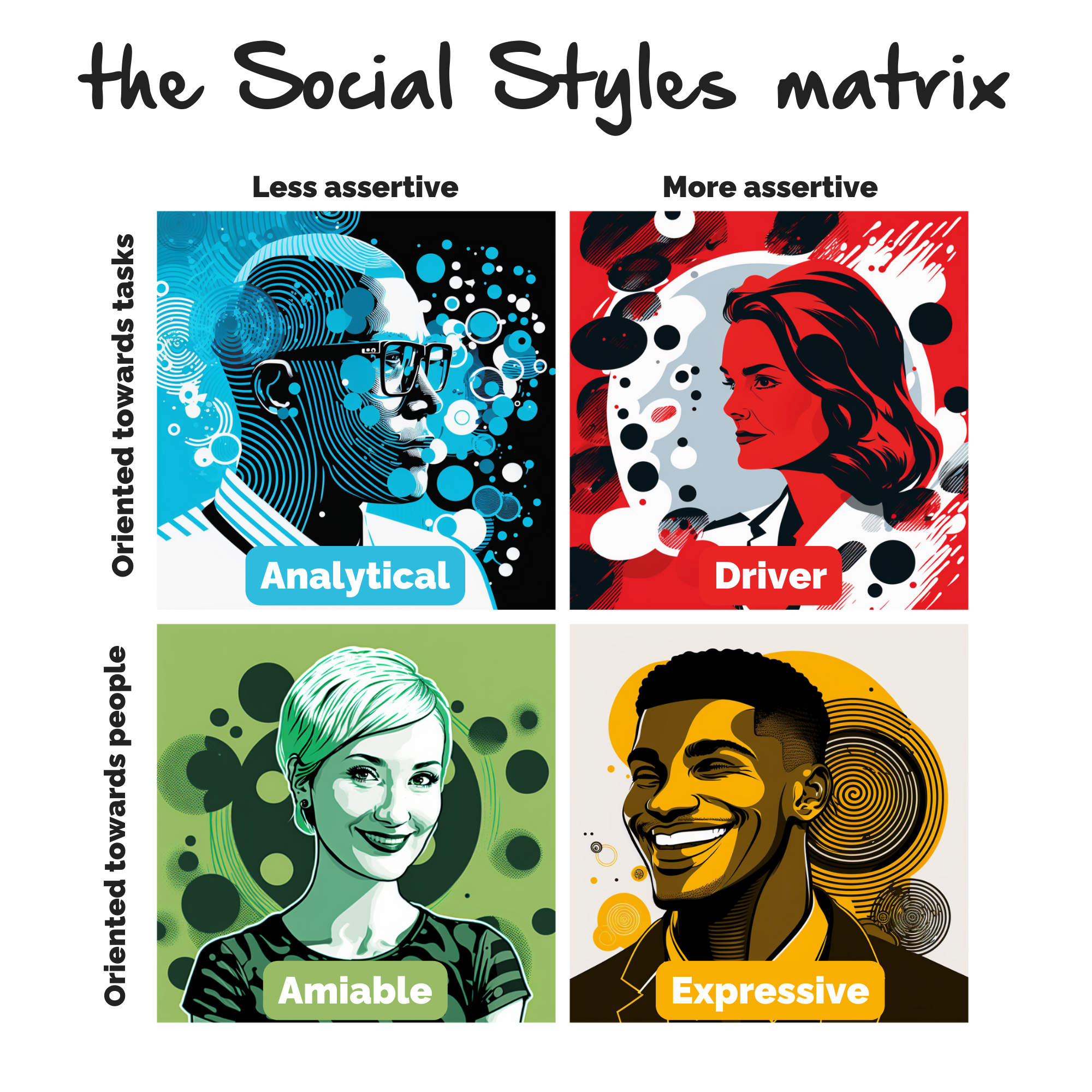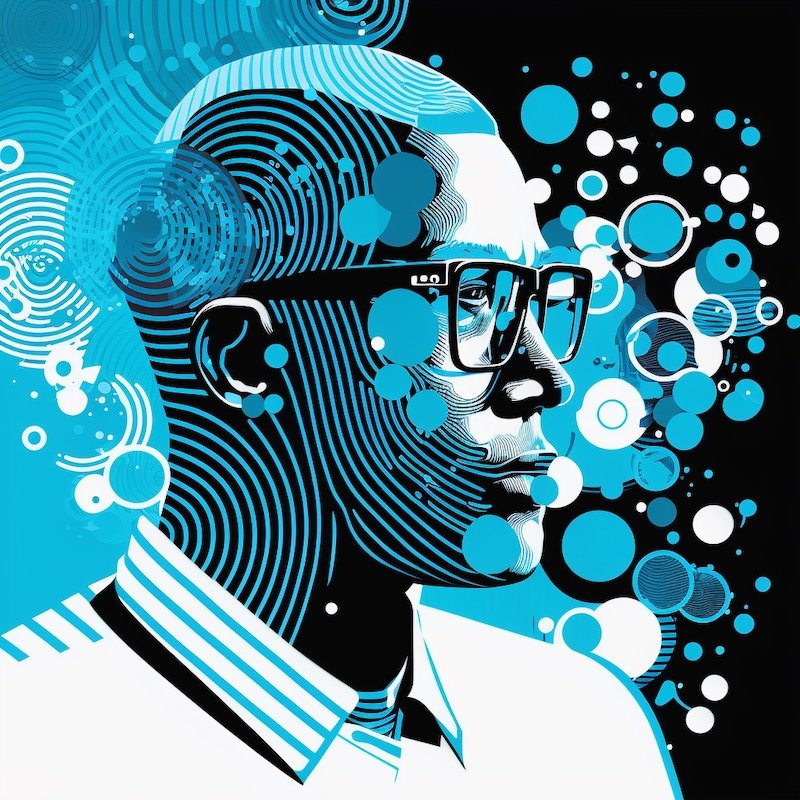The Social Styles model: communicate better with this powerful theory
Analytical, amiable, expressive or driver: there are four social styles, with their own distinct priorities.
Understand others better with the Social Styles model – and see where you are on the grid.
Do you pay attention to what is happening when other people’s behaviour gets to you? Perhaps someone fails to ask any questions, and charges straight to solution mode? Do you hate it when people give you way more information than you could possibly need? Or wish someone would hurry up and make a decision - any decision?
These are all examples of clashes between different communication preferences or social styles.
What is the social styles model?
Merill and Reid Social Styles were developed by the psychologists David Merrill and Roger Reid, who used factor analysis to identify two scales, assertiveness and responsiveness.
Assertiveness is a measure of how outwardly we try to influence others.
High-assertiveness styles are more likely to reveal their opinions, try and persuade others, and have things ‘their way’.
Low-assertiveness styles are more likely to keep their views to themselves, accommodate others, and avoid conflict.
Responsiveness is a more nuanced factor of how outwardly emotional we appear to be.
High-responsiveness social styles are more socially engaged, aware of the needs of others, and often conceptualise progress through the lens of interpersonal relationships: support, harmony, discord, praise, admiration or rejection.
Low-responsiveness styles are more socially distant, and primarily think about work with other criteria: data, metrics, accomplishment, task completion, ‘victory’ and so on.
By plotting these two dimensions on a 2x2 matrix, the model conceives of four archetypal ‘types’ that people fall into.
The social styles matrix, illustrated
Are you an analytical, driver, amiable, or expressive?
In reality, of course, there are no ‘hard lines’ between the four categories - we may be quite centrally positioned, or very assertive but neutrally-responsive, situating ourselves betwixt the driver + expressive styles. Nevertheless, you may find one of the four speaking more to you than others.
Note: social styles are about actions, not feelings
Unlike other personality tests that ask about our preferences, our social style is defined by our outward behaviour and how others perceive us. In fact, it might be better to ask others what they think you are, rather than decide for yourself. That’s because the social styles model is a tool that allows us to make rough characterisations of other people, and adapt our approach accordingly to get the results we need.
The four social styles, explained
What are the four social styles? Let’s dive in.
🙇🏽♂️ The analytical social style
‘We really need to think things through.’
The analytical social style is defined by low assertiveness, combined with an focus on tasks over people. They seek knowledge, predictability and control.
Analyticals are typically detail-oriented and prioritise gathering information: they like to have all their ducks in a row before acting, sometimes to the frustration of Driver types, who are keen to swing into motion.
But they’re also willing to follow the data where it leads, even if the implications don’t make everyone happy. This means they can be keenly perceptive and clear-headed, but can be seen as somewhat unfeeling by Amiable types.
In situations where data is limited and decisions require a greater degree of intuition, Analyticals can struggle to act on conviction alone. In fact, even ‘success’ alone is not enough to reassure analytical types - they need to understand why and how success was achieved, and how it can be controlled or repeated in the future. Otherwise, maybe we just got lucky…
Teams without analyticals are prone to inconsistent results as decisions are largely made on gut-feel and learnings are rarely documented or reflected upon. They’re also at greater risk of making major mistakes without a sceptic in the room to challenge assumptions and quantify threat.
As leaders, analyticals are good at taking control of a chaotic or unpredictable team. They’re popular types of leaders in environments where consistency and doing things ‘by the book’ are key, such as safety-critical industrial settings. In more ambiguous scenarios, their need to quantify and standardise can be seen as overly-rigid to the point of stifling, removing opportunities to adapt and improvise on-the-fly.
Communicating with analyticals is about grounding conversations in tangible information. They don’t like being wrong, but do like to get data points with which they can update their thinking. They’re reassured by rigorous things: systems, processes, checklists and guarantees. A good way to increase flexibility with someone analytical is to position an intuition or off-script initiative as an ‘experiment’ with an attendant opportunity to collect more precious data.
🚗 The driving social style
“Let’s just go for it.”
The driving social style is characterised by high assertiveness, and, like the analyst, a focus on ‘tasks’ over relationships. They seek action, results and victory.
While analytical types seek to understand, drivers simply want to win, and prefer something – anything – to be happening.
Drivers are action-oriented, ambitious and like to get on with things: they fear falling behind, missing an opportunity, or wasting time. They tend to be quite industrious, dream big, and see opportunities that other don’t. Neither are they afraid of others standing in their way.
Self-aware drivers accept that motivating others, inspiring action and planning effectively are all part of the work. Conversely, when drivers see these things are frustrating distractions from ‘getting on with it’, they are liable to be seen as harsh and unfeeling.
Teams without any ‘drivers’ can slip into stasis and steady decline, so the right driver is an exciting addition: they shake things up, get people moving, and give others the confidence to act. Driver-less teams are slow to react to changing circumstances, whereas drivers (sometimes to a fault) are quick to insist that ‘we need to do something!’
Drivers are often found in leadership positions: they naturally aspire to senior roles, which they hope will finally give them the ‘sway’ to make things happen their way, faster. However, drivers aren’t necessarily better leaders than the other social styles, as they can be seen as relentless and can be disinclined to listen to alternate perspectives. Their instinct that ‘we need to do something about this!’ is also not always correct, and strategy can become erratic as drivers can constantly chasing every competitor campaign and tech innovation du jour.
Driver leaders need trusted lieutenants with complementary social styles to provide candid feedback, analytical scrutiny and the view from the watercooler.
💁🏻♀️ The amiable social style
‘Let me know what’s good for you!’
The amiable social style combines a less-assertive approach with an orientation towards people and relationships. They seek approval and harmony.
A key motivator is simply seeing others happy, and they’re keen to try and please others and build strong relationships. When change comes, their first thought is how this will affect the people around them.
On the downside, people with an amiable social style are not great at setting boundaries, speaking up for themselves, or delivering bad news. They can become quite evasive or slippery rather than deliver an unpleasant truth.
Just as their task-driven neighbour the analyst struggles with limited information, amiables flounder without other people’s preferences to inform their decision-making. In day-to-day interactions, a default amiable response can be “I don’t mind really! What would you like best?” When amiables have a good relationship with or understanding of a customer or colleague, they will consistently go the extra mile to delight them, and moving heaven-and-earth if means not letting people down.
Amiables sometimes avoid trying new things due to the increased risk of getting things wrong.
Teams without amiable members can lack a certain warmth, cohesiveness and identity. When an amiable member leaves, they’re often mourned as the ‘heart and soul’ of the group. Amiables often do a lot of unnoticed work to defuse conflict, translate goals, join up work and reassure the wary, often at unheralded personal cost.
Leaders with an amiable social style tend to do an excellent job of getting to know members individually, building warm relationships and developing a genuine sense of team identity. The very opposite of a crusading, brusque manager, they create a real sense of psychological safety in their team by listening to concerns, clearing blockers and giving employees the confidence to experiment.
Strategically, amiables try to generate a democratic consensus for decisions. Amiable leaders are less instinctively keen to impose order, deliver negative feedback, or push people for ‘more’ – anything that might hurt people’s feelings or cause discord. They would rather do more work themselves, or rationalise poor results with excuses, than confront underperformance.
Amiable leaders can find it very difficult to manage situations where they have to upset someone: for instance as a middle manager of a overloaded team, stuck between saying no to their boss or piling more work on their staff.
The expressive social style
“Listen up, everybody! I’ve got an idea…”
People with an expressive social style have high assertiveness, with an orientation towards people. They seek excitement and recognition from others.
Compared to their less-assertive sibling the amiable, they are less afraid of being disliked, but ironically, this unconstrained nature can make them stimulating and charismatic company. They want their work to stand out, not just fit in.
They share a passion for ‘success’ with the driver, but the expressives vision of victory has people at its heart – they are less motivated by money, targets, or destroying competitors. Instead they’re drawn to the razzle-dazzle and the roar of the crowd: fame, not simply ‘results.’
In a team setting, expressives loom large socially, but compared to amiables they don’t mind speaking up, letting you know their feelings or hatching a plot. They are always keenly interested in the people around them: they take an interest, get involved, collaborate, and love a good side-channel. As a result they’re usually deeply-wired into the social systems of an organisation, and wield a lot of influence indirectly.
Expressive team leaders usually excel at inspiring their teams and making work interesting. They have a lot of ideas, and a strong aptitude for ‘reading the room’, persuasively bringing people on board. Fundraising founders often need an expressive streak to persuade investors to back their dream.
However, because expressives are bored by routine, they can start to be seen as unreliable or manipulative when they fail to follow through on commitments to their employees. And organisations may start to ‘tune out’ even exciting new initiatives, goals and ‘moonshots’, if they continually change.
Like all social styles, expressives value their fellow expressives more highly, and don’t always make the exacting contributions of analytical team members feel appreciated.
Adapting our social styles
Example: a ‘default amiable’ is more likely to try expressive communication, then more analytical, then driving, in that order.
Generally, it’s easier to adjust our level of assertiveness than our level of task-orientation, and it’s easier to change one than both.
For this reason, when we’re under stress, not getting results, or seeking a different reaction to usual, we often adapt our social style to that of our horizontal neighbour. Failing that, we then turn to the style of our vertical neighbour, and as a last resort the unfamiliar territory of our total opposite, moving through the grid in a Z (or mirror-Z) like shape.
| Default style | Plan B | Plan C | Last resort |
|---|---|---|---|
| Analytical | Driver | Amiable | Expressive |
| Driver | Analytical | Expressive | Amiable |
| Amiable | Expressive | Analytical | Driver |
| Expressive | Amiable | Driver | Analytical |
How different social styles communicate
People with a similar social style tend to get along most naturally, as they speak each other’s language and share a common vision of what ‘good’ looks like. For instance, two analyticals are likely to settle any differences through a dispassionate examination of the evidence.
Conversely, diagonally-opposed social styles are more inclined to disagree: analyticals and expressives at odds can see each other as loud-mouthed attention-seekers and heartless number-crunchers respectively, while amiables and drivers can demonise each other as lily-livered wet-blankets and hard-charging dictator-sadists.
But this needn’t be the case! Critical to cross-style communication is cultivating an appreciation for the other’s approach, incorporating their work within the model of your personal style.
For instance, a driver can accept that a happy team which feels appreciated is actually more likely to accomplish things and act with confidence.
Meanwhile, analyticals can understand expressives’ off-script shenanigans as generating experimental new data, making ad hoc discoveries that can later be understood more thoroughly and standardised.
Analyticals provide the consistent foundation on which new work can be more readily accomplished - as even Flaubert suggested “Be regular and orderly in your life, so that you may be violent and original in your work.”
💬 Persuasive communication points, by social style
Whether you’re managing a team and guiding people through organisational change, or working in sales and overcoming objections with a potential client, recognising your counterpart’s social style helps you communicate focused on the issues most important to them. Try focusing on these elements:
Analyticals: what the data suggests, what can be measured, how long things will take, how standards can be raised, how disaster will be prevented, who will be in charge, where accountability lies, under what circumstances it can be stopped, what controls and safety measures are in place, how the process will be reviewed, what knowledge or information can be cleaned along the way, that it’s the safe choice
Drivers: how quickly things can start happening, how big the potential upside is, the consequences of inaction, the return on investment, what others in the space are doing, whether this is something new, shiny and ‘elite’, how important their decision is, that it’s a ‘no-brainer’, that it’s the bold choice
Amiables: what others opinions are, how straightforward it will be, how happy it could make people, how happy it could make you, your own feelings and needs, your relationship with them, that it’s a sensible choice that won’t land them in hot water, that you trust them
Expressives: how exciting it is, how many new possibilities it will unlock, the freedom it will provide, that it’s “what everyone’s talking about”, what rumours you’ve heard, that it will really shake things up, that its a whole new world, that it’s the fun choice.
⊞ Social styles explained: grid summary
To conclude, we all contain a blend of these different social styles, and even adapt our style based on the situation we find ourselves in. No doubt, though, you’ll recognise plenty of these traits in the people around you!
By inferring their emotional needs from their outward social style, you tailor your communication to make yourself understood more readily. And by appreciating that each of the four types has something truly valuable to offer, you can overcome an instinctive reaction that there’s a ‘right’ and ‘wrong’ way to think about a problem.
See our communication training courses.









![[Guide] Handling conflict at work: what good managers do differently](https://images.squarespace-cdn.com/content/v1/6348398d9d21fd6277c64f96/1764074828110-OAKDWQ3PJ3E0VQ4BAE84/blog+images+June+2025+%2820%29.png)




